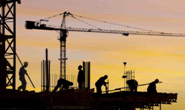Steel Markets

AGC: Nonres Construction Spending Makes Modest Gain in January
Written by Sandy Williams
March 2, 2021
Nonresidential construction spending expanded for the first time in seven months, according to a new analysis of January federal construction data by the Associated General Contractors of America. Total construction spending was $1.52 trillion in January, up 1.7% from December and 5.8% from January 2020.
Combined private and public nonresidential construction spending climbed 0.9% from December, but remained 5.0% below the year-ago level, said AGC. Residential spending, which has been strong throughout the pandemic, climbed 1.7% from December and was up 21% year-over-year.
“Despite a modest upturn in January, spending on private nonresidential construction remained at the second-lowest level in more than three years and was 10% below the January 2020 spending rate,” said Ken Simonson, the association’s chief economist. “All 11 of the private nonresidential categories in the government report were down, compared to a year earlier.”
Public construction supported most of the nonresidential spending gain, increasing 2.9% from a year ago and 1.7% from December. Mild weather helped highway and street construction gain 6.5% for the year and 5.8% for the month. Educational construction had a modest 0.9% year-over-gain, but was down 0.1% for the month. Transportation facilities also saw modest declines of 0.6% year-over-year and 1.0% from December.
Private nonresidential spending rose 0.4% from December, but fell in three of the largest sectors: power construction, commercial construction and office construction. Manufacturing construction plummeted 14.7% from a year ago, but saw a 4.9% increase in January.
New home construction has been robust and private residential spending increased for the eighth consecutive month, soaring 21% from January 2020 and gaining 2.5% from December. Single-family construction leapt 24.2% year-over year and 3.0% for the month. Multifamily construction gained 15.9% for the year and 0.7% for the month.
Contractors are paying more for lumber and steel, but are having difficulty recouping the higher charges from clients.
“Contractors are getting caught between rising materials prices and stagnant bid levels,” said Stephen E. Sandherr, the association’s chief executive officer. “Add to that the possible threat of a new era of labor unrest, and many contractors are worried that the recovery will end before it really starts.”

Sandy Williams
Read more from Sandy WilliamsLatest in Steel Markets

CRU: Sheet import demand softens as domestic price gains have slowed
US domestic sheet price gains have begun to slow as previously pulled-forward demand has led to a decline in orders.

CMC looks beyond Arizona micro-mill woes to long-term viability of construction mart
Despite the economic and geopolitical upheaval of the last five years, CMC President and CEO Peter Matt points out that the construction market has been an essential element of the way forward.

US importers face stricter rules under revamped S232 tariffs
“CBP expects full compliance from the trade community for accurate reporting and payment of the additional duties. CBP will take enforcement action on non-compliance," the agency said in a March 7 bulletin.

Steel exports rebound in January
US steel exports recovered to a five-month high in January after having fallen to a two-year low in December. This growth follows four consecutive months of declining exports.

Construction spending drops marginally in January
Construction spending edged down slightly in January, slipping for the first time in four months. The US Census Bureau estimated spending at a seasonally adjusted annual rate of $2,196 billion in January, down 0.2% from December’s downward revised rate. The January figure is 3.3% higher than a year ago. January’s result, despite the slight erosion, […]
